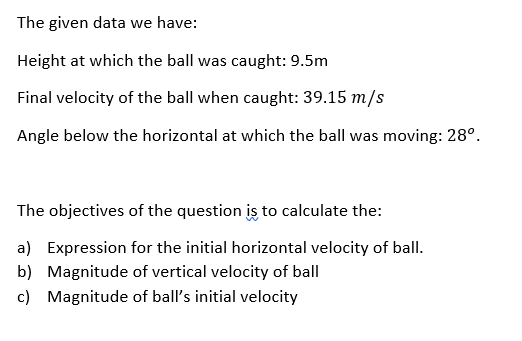A baseball slugger smacks a pitch and watches the ball soar into the bleachers for a home run, landing h=9.5mℎ=9.5m higher than it was hit. When visiting with the fan that caught the ball, he learned the ball was moving with final velocity vf=39.15m/s at an angle θf=28∘ below the horizontal when caught. Assume the ball encountered no air resistance, and use a Cartesian coordinate system with the origin located at the ball's initial position. A) Create an expression for the ball’s initial horizontal velocity, v0x0, in terms of the variables given in the problem statement. B) Calculate the magnitude, in meters per second, of the vertical component of the ball’s initial velocity. C) Calculate the magnitude, in meters per second, of the ball’s initial velocity. D) Find the angle above the horizontal, in degrees, at which the ball left the bat
A baseball slugger smacks a pitch and watches the ball soar into the bleachers for a home run, landing h=9.5mℎ=9.5m higher than it was hit. When visiting with the fan that caught the ball, he learned the ball was moving with final velocity vf=39.15m/s at an angle θf=28∘ below the horizontal when caught. Assume the ball encountered no air resistance, and use a Cartesian coordinate system with the origin located at the ball's initial position.
A) Create an expression for the ball’s initial horizontal velocity, v0x0, in terms of the variables given in the problem statement.
B) Calculate the magnitude, in meters per second, of the vertical component of the ball’s initial velocity.
C) Calculate the magnitude, in meters per second, of the ball’s initial velocity.
D) Find the angle above the horizontal, in degrees, at which the ball left the bat.

Trending now
This is a popular solution!
Step by step
Solved in 4 steps with 4 images









